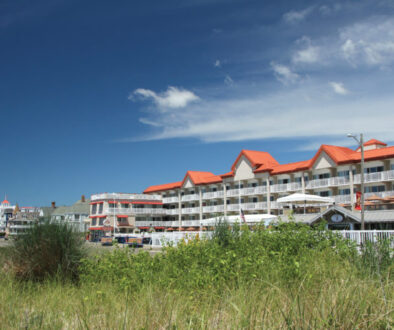Beneath the Surface: The story of the SS Atlantus

You can’t get anywhere in Cape May without passing a few pieces of history along the way. Drive down Sunset Boulevard on a summer evening, for instance, windows down, the air perfumed with salt and honeysuckle, and you can’t miss the stuccoed signposts leading to Cape May Point—once a religious retreat, now a quietly self-sufficient enclave. Further down, the World War II Lookout Tower stands promontory on the left, and just across from it, a seemingly mislaid parking lot, all that’s left of a magnesite plant dating back to 1941.
But for most visitors, Sunset Boulevard is just a means to get you to Sunset Beach—the undisputed best spot in town to watch the sun sink into the Delaware Bay. The gift shops are stocked with sea shells, stones, and keepsakes, the mini-golf course attracts a lively business, and the smell of burgers and fries from the Grille carries down to the beach. Beachcombers stoop by the water, scanning for the glint of a Cape May Diamond, and every night of the summer season, there’s a flag-lowering ceremony to the tune of Taps—a tradition that’s survived more than 40 years. It’s a piece of seaside Americana, trapped in the amber light of sunset.
Then you’ll see it, out in the water, straight past the stone jetty. Projecting from the bay there’s a skeletal structure, as much like a rib cage as anything else. When the tide is lowest you’ll see a bit more—what seems like stone and metal framework, covered in places with bright green algae, sometimes a roost for seagulls. If there weren’t a sign to tell you so, you might not even know you were looking at a shipwreck.

But it’s a ship alright—a concrete ship, the very words so incompatible they already hint at failure. The SS Atlantus was built for a war she never saw, and grounded less than a decade later. Today, it’s a swiftly disappearing monument to another time.
It started during World War I. After several years maintaining strict neutrality toward the conflict in Europe, President Woodrow Wilson declared war on Germany on April 6, 1917, responding to that country’s increased emphasis on U-boat warfare in the preceding months. Entering at the tail end of the conflict, the U.S. was coming to aid Allied forces already severely depleted, and suffered significant losses itself immediately after entering the fray. In order to better transport resources (both men and supplies), the country needed more ships. Wilson founded the Emergency Fleet Corporation 10 days after the United States declared war, with a mandate to produce new merchant vessels to aid the cause, and a $50 million bankroll to do so.
But even that sum (more than a billion in today’s dollars) couldn’t offset the scarcity of steel in 1917. Instead, naval engineers were tasked with finding affordable, plentiful alternatives to the metal. Strange as it sounds, concrete came to mind almost immediately. Smaller ships had been made of the material since the mid-1800s, but larger-scale cargo vessels were still a relatively new concept. The government invited Norseman Nikolay Fougener to conduct a study of the feasibility of bigger, tougher concrete ships. In his home country, Fougener had already built the Namsenfjord, the first self-propelled ocean-ready concrete vessel. Given his history, it’s no surprise his study ultimate endorsed the manufacture of similar ships in the United States. Not long after, the U.S. commissioned a grand total of 24 concrete ships to help the war effort.

How does concrete float? The same way any massive steel vessel floats—with air-tight compartments and a large hull. The Atlantus, for example, weighed 3000 tons, but with a hull 250 feet long, 45 feet wide, and descending 16 feet below the waterline, it displaced more than that much weight in seawater. For added structural strength, the concrete was reinforced with a skeleton of steel. The ships were planned as convenient but temporary stopgaps in the sudden ramp-up to war. In 1918, R.J. Wig, head engineer on the concrete ship project, would say: “Concrete ships will be durable for several years, and serviceable throughout the probable duration of the war. The upper limit of life expectancy is three or four years because of deteriorating elements. The present emergency calls for ships, and their life is not of great importance at this time.”
They were building themselves a disposable fleet, and as the ships took shape, the world took notice. In June of 1918, EFC draftsman E.J. Tully was arrested for trying to steal a complete set of blueprints for a concrete ship (his accomplice, a German agent, was later discovered waiting for the plans in New Orleans). Production pushed ahead, but not fast enough to aid the war effort—victory was declared on November 11, 1918, and the first of the fleet, Cape May’s own Atlantus, was christened by Mrs. Woodrow Wilson a month later in Brunswick, Georgia.

Of the original 24 ships slated for constructed, only a dozen would be built. The Atlantus was the first and most famous. The war had ended, but plenty of troops were still stranded overseas, and in her first and only year of active duty, the ship made at least two trips to France to retrieve servicemen. Following that, the steamer shuttled coal up to New England for a time, but with the war finished, and steel readily available again, the experimental ships quickly became a burden. They moved too slowly, consumed too much fuel, and weren’t well suited to trans-Atlantic trips. Sailors weren’t fond of them either; suspicious of the technology behind a concrete vessel, many took to calling them “floating tombstones.” In 1920, the Atlantus was sent to the ship’s bone yard at Pig’s Point in Norfolk, Virginia and salvaged for scrap.
The engines were removed, the useful parts resold, and the remains of the ship stayed afloat, waiting for the right buyer. In 1926, Colonel Jesse Rosenfeld made that purchase, acquiring the Atlantus not for any grand voyage, but as the cornerstone of his plan to link Delaware and New Jersey. Rosenfeld, a Baltimore native, aimed to start a ferry line between Cape May and Cape Henlopen. He needed the concrete ship not to move passengers, but as the first part of a concrete wharf. With the Atlantus as the initial outlet, Rosenfeld planned to buy two more concrete ships, digging shallow depressions for each so that they’d form a Y-shaped slip. If his plan worked, ferries could slowly slide between the two additional ships, shore up, then let foot passengers and automobiles disembark, swarming over the top deck of the Atlantus and onto Sunset Beach.
In March of 1926, the town celebrated a groundbreaking ceremony in honor of the new enterprise. Three months later, during an early summer storm, the Atlantus broke free from her mooring, drifted into the bay, struck a sandbar and ran aground about 150 feet from shore. Though the ship had no engine, it still had a caretaker aboard to make minor repairs: as the vessel moved seaward, he went on deck and began waving a white sheet. Joe Trolli, an employee at the nearby sand plant, saw the distress signal and rowed out to the Atlantus, saving the caretaker (and his cat) from any danger. Over the ensuing years, a number of rescue attempts proved unsuccessful—moving a 3,000-ton concrete behemoth is no small feat—and she was finally consigned to the waves, a lost cause just a stone’s throw from the shore.
Just as the engineers had warned, the ship was destined to disintegrate, though she’s lasted longer than her builders might have expected. First the Atlantus just listed slightly to the left. In 1937, a seam split open in the hull. By the mid-50s it began to come apart, and by 1961 it was split in two. Today, the stern is still visible, the concrete largely washed away from the steel girding beneath. At low tide, the bow peeks above the water too, though the middle section of the ship is completely submerged.

Even wrecked, the Atlantus has remained an attraction. In a silent film from 1927, a seaplane turns tight circles around the grounded ship as Coast Guardsmen practice rescue maneuvers from her deck. Later, an enterprising businessman recognized the hull as prime advertising space and installed a billboard: “For Boat Insurance, A.M. Bianchi.” For a time, thrill-seekers would swim out to the structure and dive into the water, until one man drowned in the attempt. Today visitors can still get an up-close view of the Atlantus on a kayak, and during slack tide divers have been known to explore the underwater wreckage, now coated in mussel beds, teeming with sea bass and striper, and, rumor has it, harboring sand-polished Cape May Diamonds the size of baseballs. A quick search on YouTube offers up an aerial circuit around the wreck from a drone, mimicking the same path of that Coast Guard seaplane 90 years earlier. The big difference is that today, the Atlantus is barely recognizable as a ship.
For those confused, a historical marker breaks down the story in a series of fragments. It begins:
Remains of experimental concrete ship. One of twelve built during World War I. Proven impractical after several Trans-Atlantic trips because of weight.
And it ends with a suggestion to purchase prints at the gift shop.
Today a visit to the ship isn’t the mostly visually compelling experience. Unless you know the backstory, it’s difficult to reconstruct the crumbling concrete and filigree of rusted steel in the image of a seaworthy vessel. But still there’s something poignant about the wreck, something post-apocalyptic in the decay, as if the Atlantus were a holdout from an alternate history, when the concrete ships ushered in a new age in sea travel, and shipyards turned them out by the hundreds, instead of scrapping them in New Orleans, or sinking as breakwaters off Miami, or losing them to something as simple as a summer squall.
In a city full of glamorous houses and hotels revived from past eras, it pays to remember too that not every undertaking was a success. Demolished sites, abandoned buildings, shipwrecks—these are rare in Cape May. They’re also reminders to dust off chapters in history we might otherwise forget when, say, the Atlantus finally sinks below the waterline, and no one’s prompted to point and ask “Hey! What’s that?



